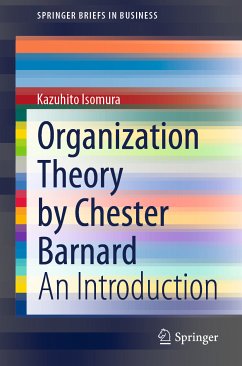This book helps undergraduate and graduate students understand Chester Barnard's organization theory. Barnard's book The Functions of the Executive is a classic that, along with Herbert Simon's Administrative Behavior, is often considered to be essential reading for management students. However, it is well known to be difficult and abstract. Offering a systematic overview, this book provides an excellent introduction to Barnard's organization theory.
Chester Barnard's concept of formal organization is often cited as a definitive opus on the subject of organization. However, he provided other concepts of organization, such as cooperative systems, complex formal organizations, and informal organizations. In his second book, Organization and Management, he added two more concepts, lateral organizations and status systems, allowing researchers to gain a better understanding of how Barnard developed his organization theory after his first publication.
Barnard was a successful practitioner as well as a theorist, and his organization theory is full of practical insights gained from managing various types of organizations, including NGOs and NPOs. This book discusses how Barnard's organization theory can be applied to business practices in the context of exploring a new style of management, and provides suggestions for business people seeking innovations for their own organizations.
Dieser Download kann aus rechtlichen Gründen nur mit Rechnungsadresse in A, B, BG, CY, CZ, D, DK, EW, E, FIN, F, GR, HR, H, IRL, I, LT, L, LR, M, NL, PL, P, R, S, SLO, SK ausgeliefert werden.
Es gelten unsere Allgemeinen Geschäftsbedingungen: www.buecher.de/agb
Impressum
www.buecher.de ist ein Internetauftritt der buecher.de internetstores GmbH
Geschäftsführung: Monica Sawhney | Roland Kölbl | Günter Hilger
Sitz der Gesellschaft: Batheyer Straße 115 - 117, 58099 Hagen
Postanschrift: Bürgermeister-Wegele-Str. 12, 86167 Augsburg
Amtsgericht Hagen HRB 13257
Steuernummer: 321/5800/1497
USt-IdNr: DE450055826









